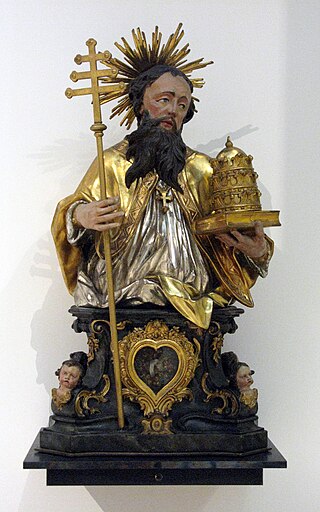
Pope Linus was the bishop of Rome from c. AD 67 to his death. As with all the early popes, he was canonized.

Pope Zachary was the bishop of Rome from 28 November 741 to his death. He was the last pope of the Byzantine Papacy. Zachary built the original church of Santa Maria sopra Minerva, forbade the traffic of slaves in Rome, negotiated peace with the Lombards, and sanctioned Pepin the Short's usurpation of the Frankish throne from Childeric III. Zachary is regarded as a capable administrator and a skillful and subtle diplomat in a dangerous time.

Agnes of Rome is a virgin martyr, venerated as a saint in the Catholic Church, Oriental Orthodox Church and the Eastern Orthodox Church, as well as the Anglican Communion and Lutheran Churches. She is one of several virgin martyrs commemorated by name in the Canon of the Mass.

Pope Pontian was the bishop of Rome from 21 July 230 to 28 September 235. In 235, during the persecution of Christians in the reign of the Emperor Maximinus Thrax, Pontian was arrested and sent to the island of Sardinia.

Hippolytus of Rome was a Bishop of Rome and one of the most important second-third century Christian theologians, whose provenance, identity and corpus remain elusive to scholars and historians. Suggested communities include Rome, Palestine, Egypt, Anatolia and other regions of the Middle East. The best historians of literature in the ancient church, including Eusebius of Caesarea and Jerome, openly confess they cannot name where Hippolytus the biblical commentator and theologian served in leadership. They had read his works but did not possess evidence of his community. Photios I of Constantinople describes him in his Bibliotheca as a disciple of Irenaeus, who was said to be a disciple of Polycarp, and from the context of this passage it is supposed that he suggested that Hippolytus so styled himself. This assertion is doubtful. One older theory asserts he came into conflict with the popes of his time and seems to have headed a schismatic group as a rival to the bishop of Rome, thus becoming an antipope. In this view, he opposed the Roman Popes who softened the penitential system to accommodate the large number of new pagan converts. However, he was reconciled to the Church before he died as a martyr.

Saint Valentine was a 3rd-century Roman saint, commemorated in Western Christianity on February 14 and in Eastern Orthodoxy on July 6. From the High Middle Ages, his Saints' Day has been associated with a tradition of courtly love. He is also a patron saint of Terni, epilepsy and beekeepers. Saint Valentine was a clergyman – either a priest or a bishop – in the Roman Empire who ministered to persecuted Christians. He was martyred and his body buried on the Via Flaminia on February 14, which has been observed as the Feast of Saint Valentine since at least the eighth century.

The Papal Archbasilica Cathedral of the Most Holy Savior and of Saints John the Baptist and the Evangelist in the Lateran is the Catholic cathedral church of the Diocese of Rome in the city of Rome, and serves as the seat of the bishop of Rome, the pope. The archbasilica lies outside of Vatican City proper, which is located approximately 4 kilometres (2.5 mi) to the northwest. Nevertheless, as properties of the Holy See, the archbasilica and its adjoining edifices enjoy an extraterritorial status from Italy, pursuant to the terms of the Lateran Treaty of 1929. Dedicated to the Christ, in honor of John the Baptist and John the Evangelist, the place name, Laterano (Lateran) comes from an ancient Roman family (gens), whose palace (domus) grounds occupied the site; the adjacent Lateran Palace was the primary residence of the pope until the Middle Ages.
A martyrology is a catalogue or list of martyrs and other saints and beati arranged in the calendar order of their anniversaries or feasts. Local martyrologies record exclusively the custom of a particular Church. Local lists were enriched by names borrowed from neighbouring churches. Consolidation occurred, by the combination of several local martyrologies, with or without borrowings from literary sources.
Antonio Maria Colini was a Roman archaeologist who studied, among other topics, the Severan marble plan of Rome known as the Forma Urbis Romae. He was part of the group of scholars associated with Italo Gismondi.

Piazza Venezia is a central hub of Rome, Italy, in which several thoroughfares intersect, including the Via dei Fori Imperiali and the Via del Corso. It takes its name from the Palazzo Venezia, built by the Venetian Cardinal, Pietro Barbo alongside the church of Saint Mark, the patron saint of Venice. The Palazzo Venezia served as the embassy of the Republic of Venice in Rome.
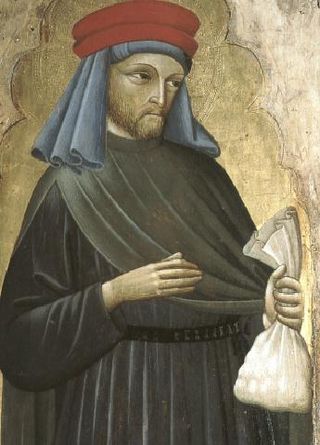
Saint Homobonus is the patron saint of business people, tailors, shoemakers, and clothworkers, as well as of Cremona, Italy.
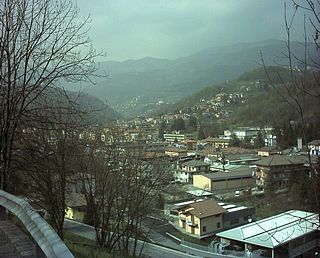
Sant'Omobono Terme is a comune (municipality) in the Province of Bergamo in the Italian region of Lombardy, located about 50 kilometres (31 mi) northeast of Milan and about 15 kilometres (9 mi) northwest of Bergamo.
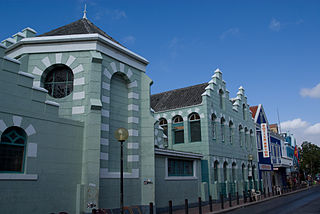
The Catholic Church in the Caribbean part of the Kingdom of the Netherlands is part of the worldwide Roman Catholic Church, under the spiritual leadership of the Pope in Rome.
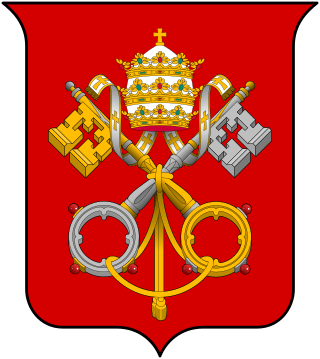
The Diocese of Rome, also called the Vicariate of Rome, is a Latin diocese of the Catholic Church under the direct jurisdiction of the Pope, who is Bishop of Rome and hence the supreme pontiff and head of the worldwide Catholic Church. As the Holy See, the papacy is a sovereign entity with diplomatic relations, and civil jurisdiction over the Vatican City State located geographically within Rome. The Diocese of Rome is the metropolitan diocese of the province of Rome, an ecclesiastical province in Italy. According to Catholic tradition, the first bishop of Rome was Saint Peter in the first century. The incumbent since 13 March 2013 is Pope Francis.

Saint Peter, also known as Peter the Apostle, Simon Peter, Simeon, Simon, or Cephas, was one of the Twelve Apostles of Jesus Christ and one of the first leaders of the early Christian Church. He appears repeatedly and prominently in all four New Testament gospels as well as the Acts of the Apostles. Catholic and Orthodox tradition accredits Peter as the first bishop of Rome—or pope—and also as the first bishop of Antioch.

The Sant'Omobono Area is an archaeological site in Rome next to the church of Sant'Omobono, at the junction of via L. Petroselli and the Vico Jugario at the foot of the Campidoglio. It was discovered in 1937 and contains much important evidence for archaic and republican Rome. It contains altars and the sites of the temple of Fortuna and the temple of Mater Matuta. An earlier archaic-period temple underlies these two, dating itself to the early 6th century BCE, making it the oldest known temple remains in Rome.
The Temple of Ops was a minor temple on the Capitoline Hill in Rome. It was dedicated to Ops, the deity of abundance.
The Temple of Fides was a minor temple on the Capitoline Hill in Rome. It was dedicated to Fides, the goddess of good faith, who was patron of diplomatic relations.
Sant'Omobono is a Roman Catholic church located on the piazzetta di Sant'Omobono, in central Cremona, region of Lombardy, Italy. The church faces across the piazza, the Palazzo Pallavicino and Palazzo Cattaneo. The piazza was formerly a cemetery used during time of the plague.

The following outline is provided as an overview of and topical guide to Rome:

















